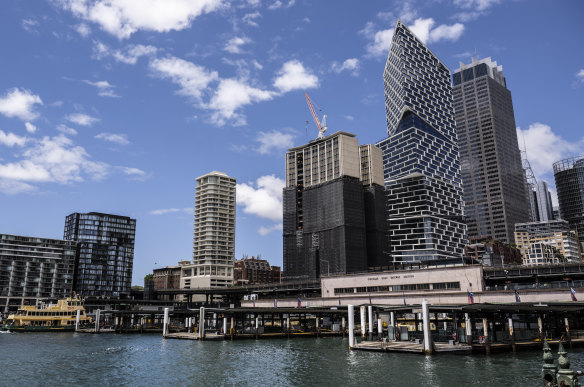This was published 2 years ago
From low-raze to top praise: Sydney high-rise wins international architecture prize
By Julie Power
It could have been razed and turned to rubble, but a turbocharged upcycling of a typical 1970s office block into Sydney’s Quay Quarter Tower has beaten 33 global projects to win a top prize for the world’s best high-rise.
Quay Quarter Tower’s architects 3XN and BVN, with developers AMP Capital, were singled out for “radical sustainability” that saved 7500 tonnes in carbon dioxide emissions, compared to the impact of demolishing and rebuilding on the site.

Sydney’s Quay Quarter Tower has won a top prize for being the world’s best high-rise.Credit: Louise Kennerley
Launched in 2005, the winner of the International High-Rise Award receives €50,000 ($77,500) to donate to a charitable cause.
Awarded by the City of Frankfurt, The German Architecture Museum (DAM), and DekaBank, the prize recognises a high-rise of “exemplary sustainability, outer shape, inner spatial qualities, and social aspects to form a superior building”.
Instead of demolishing the old AMP Centre at 50 Bridge Street in the city, Danish architecture firm 3XN – which developed the design with BVN – retained the southern side of the building and its core.
To create light-filled villages within the building, the architects added five cantilevered glass boxes, which they likened to wooden Jenga blocks.
Fred Holt, a partner at 3XN, was in Germany to accept the prize and described the process as “humanising the high-rise”.
Two-thirds of the beams, columns and floor slabs and 95 per cent of the original core built for the AMP Society in the 1970s were retained.
This low-raze approach to high-rise added more floors. New atriums were designed with flexible floor plans – so floors could be added or removed – to suit the changing needs of clients.
Author and expert on tall buildings and sustainability Associate Professor Philip Oldfield said Quay Quarter Tower was one of the most important tall buildings this century.
“This is architecture transforming a building that had reached the end of its useful life into something entirely new,” said Oldfield, the head of school at UNSW Built Environment.
There were many examples of buildings that had been refurbished, with improved skin for energy efficiency or to make them more modern, but “what we haven’t seen is something like this”, he said.
“It is a total transformation of the architecture, the floor plate is extended, the building is reimagined, you would not recognise the building today. That is relatively rare. ”
He said there were thousands of mid-century office buildings around the world at risk of being demolished when they could be repurposed, reducing the effect on the climate.
The other finalists
Often they’re being replaced with a slightly bigger, slightly glassier versions, he said.
“People either love them or hate them [modernist office blocks] ... But what this generation of buildings have is an environmental importance: They are a previous investment of thousands of tonnes of concrete and thousands of tonnes of steel.”
Every square metre of new floor space produces an estimated tonne of greenhouse gases, Oldfield said. And new international research showed emissions generated from manufacturing concrete have doubled in the past 20 years.
“So putting aside the cultural and aesthetic heritage, [these buildings] have an environmental heritage, so we have an environmental kind of lever to look after them and, rather than pull them down, think about what they can be.
“We need to build more housing, hospitals, buildings, but every very square metre produces greenhouse gases. So one of the things we can do is renovate before we demolish and rebuild.”
The Morning Edition newsletter is our guide to the day’s most important and interesting stories, analysis and insights. Sign up here.